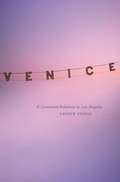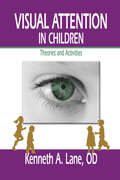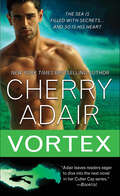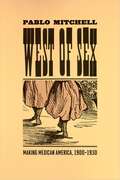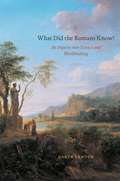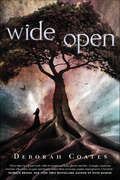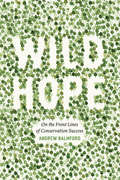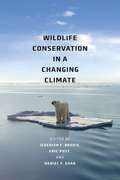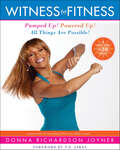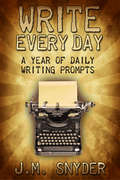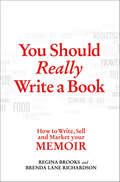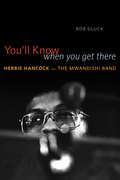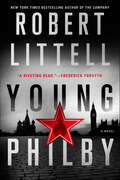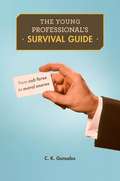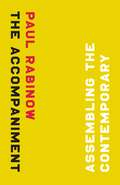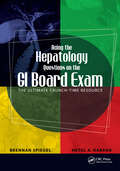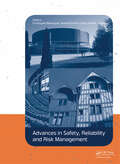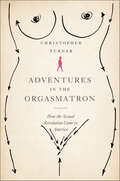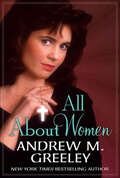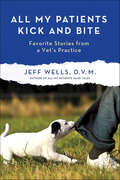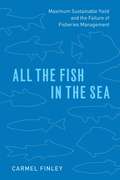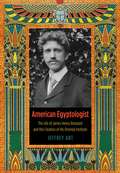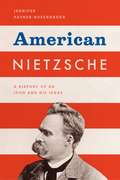- Table View
- List View
Venice: A Contested Bohemia in Los Angeles
by Andrew DeenerNestled between Santa Monica and Marina del Rey, Venice is a Los Angeles community filled with apparent contradictions. There, people of various races and classes live side by side, a population of astounding diversity bound together by geographic proximity. From street to street, and from block to block, million dollar homes stand near housing projects and homeless encampments; and upscale boutiques are just a short walk from the (in)famous Venice Beach where artists and carnival performers practice their crafts opposite cafés and ragtag tourist shops. In Venice: A Contested Bohemia in Los Angeles, Andrew Deener invites the reader on an ethnographic tour of this legendary California beach community and the people who live there. In writing this book, the ethnographer became an insider; Deener lived as a resident of Venice for close to six years. Here, he brings a scholarly eye to bear on the effects of gentrification, homelessness, segregation, and immigration on this community. Through stories from five different parts of Venice—Oakwood, Rose Avenue, the Boardwalk, the Canals, and Abbot Kinney Boulevard— Deener identifies why Venice maintained its diversity for so long and the social and political factors that threaten it. Drenched in the details of Venice’s transformation, the themes and explanations will resonate far beyond this one city. Deener reveals that Venice is not a single locale, but a collection of neighborhoods, each with its own identity and conflicts—and he provides a cultural map infinitely more useful than one that merely shows streets and intersections. Deener's Venice appears on these pages fully fleshed out and populated with a stunning array of people. Though the character of any neighborhood is transient, Deener's work is indelible and this book will be studied for years to come by scholars across the social sciences.
Visual Attention in Children: Theories and Activities
by Kenneth LaneIn typical child development, attention controls many aspects of learning, including memory, motor control, and problem solving. Attention organizes the constant influx of information that needs to be absorbed by children. Inside Visual Attention in Children: Theories and Activities, Dr. Kenneth A. Lane describes the positive aspects of attention that are needed for children to be successful in the classroom, such as concentration and vigilance, as opposed to negative aspects that can lead to failure, such as distractibility and confusion. This book is divided into two parts. The first eight chapters of the book explain attention and its relationship to vision and visual stimuli. The core topics discussed here include Autism, ADHD, Dyslexia, Executive Function, and Memory. The second half outlines a Vision Therapy program and consists of activities for improving visual attention in children. Over 100 activities are explained and illustrated.Visual Attention in Children: Theories and Activities is anchored on current theories in five areas of attention that shape child development.Theories Described Include:• Focused Attention – The ability to respond discreetly to visual, auditory, and tactile stimuli• Selective Attention – The ability to maintain behavioral or cognitive abilities in the face of distracting or competing stimuli• Shifting Attention – The ability to rapidly shift attention from one object to another• Sustained Attention – The ability to maintain a consistent behavioral response during a continuous or repetitive activity• Divided Attention –The ability to engage in more than one attention-focused task at one time.Visual Attention in Children: Theories and Activities is the perfect tool for occupational therapy students and clinicians as well as other professionals specializing in child development and learning who are looking to enhance their understanding of this topic and who need unique ideas and activities to add to their visual therapy training programs.
Vortex (Cutter Cay #3)
by Cherry AdairThe thrid book in Cherry Adair's Cutter Cay series plunges into a Vortex of high-sea adventure and romance, where a long-lost treasure is a deadly lure—and love is the most dangerous current of all…SWEPT AWAYSearching for a sunken ship off the coast of Peru, treasure hunter Logan Cutter manages to pull a very different kind of prize from the sea—beautiful gallery owner Daniela Rosada. Dani claims she was thrown overboard by ruthless pirates and begs for his protection. But Logan is no stranger to a woman's lies, and something about her story doesn't add up.IN TOO DEEPWith her knowledge of Peruvian artifacts, Dani offers to help Logan translate an ancient map that will lead them to a shipwrecked treasure—and into a carefully laid trap. But the closer they get, the deeper she falls for him, not realizing that Logan is hiding a secret of his own. By the time she learns the truth about his boat, his brothers—and his blood feud with pirates—it's too late. By falling in love, they've set a course for disaster…"Thrilling and hazardous! When you add in the sensuous sizzle, you have the full Adair package." —Romantic Times on Undertow
West of Sex: Making Mexican America, 1900–1930
by Pablo MitchellSex can be an oppressive force, a tool to shame, divide, and control a population. But it can also be a force for change, for the legal and physical challenge of inequity and injustice. In West of Sex, Pablo Mitchell uses court transcripts and criminal cases to provide the first coherent picture of Mexican-American sexuality at the turn of the twentieth century, and a truly revelatory look at sexual identity in the borderlands. As Mexicans faced a rising tide of racial intolerance in the American West, some found cracks in the legal system that enabled them to assert their rights as full citizens, despite institutional hostility. In these chapters, Mitchell offers a rare glimpse into the inner workings of ethnicity and power in the United States, placing ordinary Mexican women and men at the center of the story of American sex, colonialism, and belonging. Other chapters discuss topics like prostitution, same-sex intimacy, sexual violence, interracial romance, and marriage with an impressive level of detail and complexity. Written in vivid and accessible prose, West of Sex offers readers a new vision of sex and race in American history.
What Did the Romans Know?: An Inquiry into Science and Worldmaking
by Daryn LehouxWhat did the Romans know about their world? Quite a lot, as Daryn Lehoux makes clear in this fascinating and much-needed contribution to the history and philosophy of ancient science. Lehoux contends that even though many of the Romans’ views about the natural world have no place in modern science—the umbrella-footed monsters and dog-headed people that roamed the earth and the stars that foretold human destinies—their claims turn out not to be so radically different from our own. Lehoux draws upon a wide range of sources from what is unquestionably the most prolific period of ancient science, from the first century BC to the second century AD. He begins with Cicero’s theologico-philosophical trilogy On the Nature of the Gods, On Divination, and On Fate, illustrating how Cicero’s engagement with nature is closely related to his concerns in politics, religion, and law. Lehoux then guides readers through highly technical works by Galen and Ptolemy, as well as the more philosophically oriented physics and cosmologies of Lucretius, Plutarch, and Seneca, all the while exploring the complex interrelationships between the objects of scientific inquiry and the norms, processes, and structures of that inquiry. This includes not only the tools and methods the Romans used to investigate nature, but also the Romans’ cultural, intellectual, political, and religious perspectives. Lehoux concludes by sketching a methodology that uses the historical material he has carefully explained to directly engage the philosophical questions of incommensurability, realism, and relativism. By situating Roman arguments about the natural world in their larger philosophical, political, and rhetorical contexts, What Did the Romans Know? demonstrates that the Romans had sophisticated and novel approaches to nature, approaches that were empirically rigorous, philosophically rich, and epistemologically complex.
When in Doubt, Add Butter: A Novel
by Beth HarbisonFrom the New York Times bestselling author of Shoe Addicts Anonymous and Always Something There to Remind Me comes a delicious new novel about the search for true love and all the ingredients that go into it.As far as Gemma is concerned, her days of dating are over. In fact, it's her job to cater other peoples' dates, and that's just fine by her. At thirty-seven, she has her own business, working as a private chef, and her life feels full and secure. She's got six steady clients that keep her hands full. There's Lex, the fussy but fabulous department store owner who loves Oysters Rockefeller and 1950s comfort food; Willa, who needs to lose weight under doctor's orders but still believes butter makes everything better; a colorful family who may or may not be part of the Russian mob; an überwealthy Georgetown family; the picture-perfect Van Houghtens, whose matriarch is "allergic to everything"; and finally, a man she calls "Mr. Tuesday," whom she has never met but who she is strangely drawn to. For Gemma, cooking is predictable. Recipes are certain. Use good ingredients, follow the directions, and you are assured success. Life, on the other hand, is full of variables. So when Gemma's takes an unexpected turn on a road she always thought was straight and narrow, she must face her past and move on in ways she never would have imagined. Because sometimes in life, all you need is a little hope, a lot of courage, and---oh yes---butter.
Wide Open (Hallie Michaels #1)
by Deborah CoatesWide Open by Deborah Coates is the first book in a series of "startlingly original" (Booklist) contemporary fantasy novels set against the sweeping prairies and desolate byways of the American Midwest, creating "a rural backwater where the normal and paranormal seamlessly merge." (Publishers Weekly)When Sergeant Hallie Michaels comes back to South Dakota from Afghanistan on ten days' compassionate leave, her sister Dell's ghost is waiting at the airport to greet her.The sheriff says that Dell's death was suicide, but Hallie doesn't believe it. Something happened or Dell's ghost wouldn't still be hanging around. Friends and family, mourning Dell's loss, think Hallie's letting her grief interfere with her judgment.The one person who seems willing to listen is the deputy sheriff, Boyd Davies, who shows up everywhere and helps when he doesn't have to. As Hallie asks more questions, she attracts new ghosts, women who disappeared without a trace. Soon, someone's trying to beat her up, burn down her father's ranch, and stop her investigation.Hallie's going to need Boyd, her friends, and all the ghosts she can find to defeat an enemy who has an unimaginable ancient power at his command.--Wide Open has been nominated for the Bram Stoker Award for Superior Achievement in a First Novel, appeared on Locus Magazine's Recommended Reading List for first novels, and was chosen as a Tor.com Reviewer's Choice Pick for Favorite Book of the year. The Magazine of Fantasy & Science Fiction claimed that it is "one of the best first novels I've read in a long time" and Library Journal agrees that "fans of urban fantasies should enjoy the kick-ass [heroine]."At the Publisher's request, this title is being sold without Digital Rights Management Software (DRM) applied.
Wild Hope: On the Front Lines of Conservation Success
by Andrew BalmfordTropical deforestation. The collapse of fisheries. Unprecedented levels of species extinction. Faced with the plethora of gloom-and-doom headlines about the natural world, we might think that environmental disaster is inevitable. But is there any good news about the environment? Yes, there is, answers Andrew Balmford in Wild Hope, and he offers several powerful stories of successful conservation to prove it. This tragedy is still avoidable, and there are many reasons for hope if we find inspiration in stories of effective environmental recovery. Wild Hope is organized geographically, with each chapter taking readers to extraordinary places to meet conservation’s heroes and foot soldiers—and to discover the new ideas they are generating about how to make conservation work on our hungry and crowded planet. The journey starts in the floodplains of Assam, where dedicated rangers and exceptionally tolerant villagers have together helped bring Indian rhinos back from the brink of extinction. In the pine forests of the Carolinas, we learn why plantation owners came to resent rare woodpeckers—and what persuaded them to change their minds. In South Africa, Balmford investigates how invading alien plants have been drinking the country dry, and how the Southern Hemisphere’s biggest conservation program is now simultaneously restoring the rivers, saving species, and creating tens of thousands of jobs. The conservation problems Balmford encounters are as diverse as the people and their actions, but together they offer common themes and specific lessons on how to win the battle of conservation—and the one essential ingredient, Balmford shows, is most definitely hope. Wild Hope, though optimistic, is a clear-eyed view of the difficulties and challenges of conservation. Balmford is fully aware of failed conservation efforts and systematic flaws that make conservation difficult, but he offers here innovative solutions and powerful stories of citizens, governments, and corporations coming together to implement them. A global tour of people and programs working for the planet, Wild Hope is an emboldening green journey.
Wildlife Conservation in a Changing Climate
by Jedediah F. Brodie, Eric Post, and Daniel F. DoakHuman-induced climate change is emerging as one of the gravest threats to biodiversity in history, and while a vast amount of literature on the ecological impact of climate change exists, very little has been dedicated to the management of wildlife populations and communities in the wake of unprecedented habitat changes. Wildlife Conservation in a Changing Climate is an essential resource, bringing together leaders in the fields of climate change ecology, wildlife population dynamics, and environmental policy to examine the impacts of climate change on populations of terrestrial vertebrates. Chapters assess the details of climate change ecology, including demographic implications for individual populations, evolutionary responses, impacts on movement patterns, alterations of species interactions, and predicting impacts across regions. The contributors also present a number of strategies by which conservationists and wildlife managers can counter or mitigate the impacts of climate change as well as increase the resilience of wildlife populations to such changes. A seminal contribution to the fields of ecology and conservation biology, Wildlife Conservation in a Changing Climate will serve as the spark that ignites a new direction of discussions about and action on the ecology and conservation of wildlife in a changing climate.
Witness to Fitness: Pumped Up! Powered Up! All Things are Possible!
by Donna Richardson JoynerFrom the renowned expert behind the bestselling "Body Gospel" fitness DVDs comes Witness to Fitness, the first program to combine faith, food, and fitness—a unique plan for getting in shape that harnesses the strength and support found in God’s love.Donna Richardson Joyner’s joy in her Christian faith is contagious. So is her belief that losing weight and taking care of your body means giving glory to God. In Witness to Fitness, she inspires you to follow her on a unique 28-day journey to good health and a deeper love of God, using faith to empower change.Each day in her dynamic plan includes an inspiring scriptural quote, a personal testimony, a menu with delicious recipes, four-color photographs demonstrating a particular workout, and an inspirational song suggestion that adds the right beat to keep you moving
World of Work: Challenges for South African students
by M. C. LebitsoWork has always been part of man’s history and a crucial factor in social organisation. According to the traditional career development perspective, work is viewed as having many dimensions or functions. The intention of this book is to highlight challenges faced by students when they are ‘ready’ to enter the world of work after leaving school or after finishing tertiary education.
Write Every Day: 365 Daily Prompts for Writers (Write Every Day #1)
by J. M. SnyderWriting prompts are a great way to jumpstart your muse and get the creative juices flowing. Sometimes you want to write and don’t really know what to write about, and prompts can help guide you into a new story.This collection of 366 writing prompts can be used daily throughout the year (leap years, too!) as a starting point to get you writing ... andkeepyou writing. Each day of the year has its own, unique prompt. Set a timer for fifteen or twenty minutes, and write wherever the prompt takes you. Or, if you’re between stories and looking for something different to work on, flip to the prompt for today (or any random page) and start fresh.This book will kick-start your writing or take you in exciting new directions every day of the year!
You Should Really Write a Book: How to Write, Sell and Market your Memoir
by Brenda Lane Richardson Regina BrooksEven if you don't happen to be a celebrity, this book will teach you methods for striking publishing gold—conceptualizing, selling, and marketing a memoir—while dealing with the complicated emotions that arise during the creation of your work. If you've ever been told that "You should really write a book" and you've decided to give it a try, this book is for you. It hones in on the three key measures necessary for aspiring authors to conceptualize, sell, and market their memoirs. Written especially for those who don't happen to be celebrities You Should Really Write a Book reveals why and how so many relatively unknown memoirists are making a name for themselves. With references to more than four hundred books and six memoir categories, this is essential reading for anyone wanting to write a commercially viable memoir in today's vastly changing publishing industry. The days are long gone when editors and agents were willing to take on a manuscript simply because it was based on a "good" idea or even because it was well written. With eyes focused on the bottom line, they now look for skilled and creative authors with an established audience, too.Brooks and Richardson use the latest social networking, marketing, and promotional trends and explain how to conceptualize and strategize campaigns that cause buzz, dramatically fueling word-of-mouth and attracting attention in the publishing world and beyond. Full of current examples and in-depth analysis, this guide explains what sells and why, teaches writers to think like publishers, and offers guidance on dealing with complicated emotions—essential tools for maximizing memoir success.
You'll Know When You Get There: Herbie Hancock and the Mwandishi Band
by Bob GluckAs the 1960s ended, Herbie Hancock embarked on a grand creative experiment. Having just been dismissed from the celebrated Miles Davis Quintet, he set out on the road, playing with his first touring group as a leader until he eventually formed what would become a revolutionary band. Taking the Swahili name Mwandishi, the group would go on to play some of the most innovative music of the 1970s, fusing an assortment of musical genres, American and African cultures, and acoustic and electronic sounds into groundbreaking experiments that helped shape the American popular music that followed. In You’ll Know When You Get There, Bob Gluck offers the first comprehensive study of this influential group, mapping the musical, technological, political, and cultural changes that they not only lived in but also effected. Beginning with Hancock’s formative years as a sideman in bebop and hard bop ensembles, his work with Miles Davis, and the early recordings under his own name, Gluck uncovers the many ingredients that would come to form the Mwandishi sound. He offers an extensive series of interviews with Hancock and other band members, the producer and engineer who worked with them, and a catalog of well-known musicians who were profoundly influenced by the group. Paying close attention to the Mwandishi band’s repertoire, he analyzes a wide array of recordings—many little known—and examines the group’s instrumentation, their pioneering use of electronics, and their transformation of the studio into a compositional tool. From protofunk rhythms to synthesizers to the reclamation of African identities, Gluck tells the story of a highly peculiar and thrillingly unpredictable band that became a hallmark of American genius.
Young Philby: A Novel
by Robert LittellA Kirkus Best Fiction Book of 2012A Kansas City Star Top Book the YearWhen Kim Philby fled to Moscow in 1963, he became the most notorious double agent in the history of espionage. Recruited into His Majesty's Secret Intelligence Service at the beginning of World War II, he rose rapidly in the ranks to become the chief liaison officer with the CIA in Washington after the war. The exposure of other members of the group of British double agents known as the Cambridge Five led to the revelation that Philby had begun spying for the Soviet Union years before he joined the British intelligence service. He eventually fled to Moscow one jump ahead of British agents who had come to arrest him, and spent the last twenty-five years of his life in Russia. In Young Philby, Robert Littell recounts the little-known story of the spy's early years. Through the words of Philby's friends and lovers, as well as his Soviet and English handlers, we follow the evolution of a mysteriously beguiling man who kept his masters on both sides of the Iron Curtain guessing about his ultimate loyalties. As each layer of ambiguity is exposed, questions surface: What made this infamous double (or should that be triple?) agent tick? And, in the end, who was the real Kim Philby?
The Young Professional’s Survival Guide: From Cab Fares to Moral Snares
by C. K. GunsalusImagine yourself in your new job, doing your best to make a good impression—and your boss asks you to do something that doesn’t feel right, like fudge a sales report, or lie to a customer. You have no idea how to handle the situation, and your boss is hovering. When you’re caught off guard, under pressure from someone more powerful, it’s easy to make a mistake. And having made one, it’s easier to rationalize the next one.The Young Professional’s Survival Guide shows how to avoid these traps in the first place, and how to work through them if you can’t avoid them. Many of the problems that arise in the workplace are predictable. C. K. Gunsalus, a nationally recognized expert on professional ethics, uses short, pungent real-world examples to help people new to the work world recognize the situations that can lead to career-damaging missteps—and prevent them. Gunsalus offers questions to ask yourself (and others) to help you recognize trouble and temptation, sample scripts to use to avoid being pressured into doing something you’ll regret, and guidance in handling disputes fairly and diplomatically. Most of all, she emphasizes, choose your mentors for their characters as well as their titles and talents.You can’t control the people around you, but you can control what you do. Reliance on a few key habits and a professional persona, Gunsalus shows, can help you advance with class, even in what looks like a “casual” workplace.
The Accompaniment: Assembling the Contemporary
by Paul RabinowIn this culmination of his search for anthropological concepts and practices appropriate to the twenty-first century, Paul Rabinow contends that to make sense of the contemporary anthropologists must invent new forms of inquiry. He begins with an extended rumination on what he gained from two of his formative mentors: Michel Foucault and Clifford Geertz. Reflecting on their lives as teachers and thinkers, as well as human beings, he poses questions about their critical limitations, unfulfilled hopes, and the lessons he learned from and with them. This spirit of collaboration animates The Accompaniment, as Rabinow assesses the last ten years of his career, largely spent engaging in a series of intensive experiments in collaborative research and often focused on cutting-edge work in synthetic biology. He candidly details the successes and failures of shifting his teaching practice away from individual projects, placing greater emphasis on participation over observation in research, and designing and using websites as a venue for collaboration. Analyzing these endeavors alongside his efforts to apply an anthropological lens to the natural sciences, Rabinow lays the foundation for an ethically grounded anthropology ready and able to face the challenges of our contemporary world.
Acing the Hepatology Questions on the GI Board Exam: The Ultimate Crunch-Time Resource
by Brennan Spiegel Hetal KarsanHepatology is an expanding field - it's hard to keep up. The liver has been sitting there the whole time, but the knowledge surrounding this perplexing organ is exploding; this makes it hard to prepare for board and recertification exams, where 1 in every 4 questions pertains to hepatology. Until now, there has been no single, slim, but high-yield volume that summarises the hepatology you need to know for the boards. This book has it nailed. The authors have collected every pearl of wisdom, high-yield factlet, liver ""board buzzword,"" hepatic micrograph, and classic liver imaging study they could muster, all while keeping the book a manageable size - because who has time for more than manageable when you're busy?The answer to your study questions (and study time!) can be found inside: Acing the Hepatology Questions on the GI Board Exam: The Ultimate Crunch-Time Resource.Traditional textbooks usually feature long and detailed discussions that are not directly related to Board and recertification exams. On the flip side, many Board review manuals provide lists and bullet points lacking sufficient background and context. Inside Acing the Hepatology Questions on the GI Board Exam, Drs. Brennan Spiegel and Hetal Karsan present time-tested and high-yield information in a rational, useful, and contextually appealing format.With its focus on pearl after pearl, emphasis on images, and attention to high-yield "tough stuff" vignettes you don't know the answers to (yet), Acing the Hepatology Questions on the GI Board Exam is truly the ultimate crunch-time resource for acing often vexing liver section of the examination, taking recertifying examinations, looking good on clerkship rounds, or for just challenging yourself with interesting and entertaining vignettes.
Advances in Safety, Reliability and Risk Management: ESREL 2011
by C. Guedes Soares Christophe Bérenguer Antoine GrallCovering a wide range of topics on safety, reliability and risk management, the present publication will be of interest to academics and professionals working in a wide range of scientific, industrial and governmental sectors, including: Aeronautics and Aerospace; Chemical and Process Industry; Civil Engineering; Critical Infrastructures; Energy; Information Technology and Telecommunications; Land Transportation; Manufacturing; Maritime Transportation; Mechanical Engineering; Natural Hazards; Nuclear Industry; Offshore Industry; Policy Making and Public Planning.
Adventures in the Orgasmatron: How the Sexual Revolution Came to America
by Christopher TurnerOne of The Economist's 2011 Books of the Year A Boston Globe Best Nonfiction Book of 2011 Well before the 1960s, a sexual revolution was under way in America, led by expatriated European thinkers who saw a vast country ripe for liberation. In Adventures in the Orgasmatron, Christopher Turner tells the revolution's story—an illuminating, thrilling, often bizarre story of sex and science, ecstasy and repression. Central to the narrative is the orgone box—a tall, slender construction of wood, metal, and steel wool. A person who sat in the box, it was thought, could elevate his or her "orgastic potential." The box was the invention of Wilhelm Reich, an outrider psychoanalyst who faced a federal ban on the orgone box, an FBI investigation, a fraught encounter with Einstein, and bouts of paranoia. In Turner's vivid account, Reich's efforts anticipated those of Alfred Kinsey, Herbert Marcuse, and other prominent thinkers—efforts that brought about a transformation of Western views of sexuality in ways even the thinkers themselves could not have imagined.
All About Women
by Andrew M. GreeleyYou're in for an unforgettable experience when America's master storyteller turns his enormous narrative gifts to the passionate, haunting subject of the American woman, searching for--and often finding--love and faith... in Andrew M. Greeley's All About Women. There's teenaged Rosemarie, coming to grips with the evil of the twentieth century--or is it the evil in the human heart?Peggy, whose widowhood plunges her into the cold of loneliness.Rita, whose marriage is rich and fulfilling--except at its core.Laura, torn between three lovers, one of them a seminarian.Julie, haunted by something that happened long ago.Sionna Marie, an imp diving passionately into adulthood.And Patricia, caught in a web she may not have the power to break.At the Publisher's request, this title is being sold without Digital Rights Management Software (DRM) applied.
All My Patients Kick and Bite: Favorite Stories from a Vet's Practice
by Jeff WellsThe highly amusing, uplifting and entertaining follow-up to All My Patients Have TalesIn this second collection by our intrepid vet, Jeff Wells has his work cut out for him when he learns thatllamas do not take kindly to having their toenails trimmed, dog owners in the medical field can be a real pain, Scottish Highland cattle stick together and just might run a vet out of their enclosure, and fixing an overly amorous burro often needs to be prioritized. Told with Wells's trademark humor and gentle touch, these and many other heartwarming, heartbreaking, funny and strange stories will give readers a whole new appreciation for those who care for our pets..
All the Fish in the Sea: Maximum Sustainable Yield and the Failure of Fisheries Management
by Carmel FinleyBetween 1949 and 1955, the State Department pushed for an international fisheries policy grounded in maximum sustainable yield (MSY). The concept is based on a confidence that scientists can predict, theoretically, the largest catch that can be taken from a species’ stock over an indefinite period. And while it was modified in 1996 with passage of the Sustained Fisheries Act, MSY is still at the heart of modern American fisheries management. As fish populations continue to crash, however, it is clear that MSY is itself not sustainable. Indeed, the concept has been widely criticized by scientists for ignoring several key factors in fisheries management and has led to the devastating collapse of many fisheries. Carmel Finley reveals that the fallibility of MSY lies at its very inception—as a tool of government rather than science. The foundational doctrine of MSY emerged at a time when the US government was using science to promote and transfer Western knowledge and technology, and to ensure that American ships and planes would have free passage through the world’s seas and skies. Finley charts the history of US fisheries science using MSY as her focus, and in particular its application to halibut, tuna, and salmon fisheries. Fish populations the world over are threatened, and All the Fish in the Sea helps to sound warnings of the effect of any management policies divested from science itself.
American Egyptologist: The Life of James Henry Breasted and the Creation of His Oriental Institute
by Jeffrey AbtJames Henry Breasted (1865–1935) had a career that epitomizes our popular image of the archaeologist. Daring, handsome, and charismatic, he traveled on expeditions to remote and politically unstable corners of the Middle East, helped identify the tomb of King Tut, and was on the cover of Time magazine. But Breasted was more than an Indiana Jones—he was an accomplished scholar, academic entrepreneur, and talented author who brought ancient history to life not just for students but for such notables as Teddy Roosevelt and Sigmund Freud.In American Egyptologist, Jeffrey Abt weaves together the disparate strands of Breasted’s life, from his small-town origins following the Civil War to his evolution into the father of American Egyptology and the founder of the Oriental Institute in the early years of the University of Chicago. Abt explores the scholarly, philanthropic, diplomatic, and religious contexts of his ideas and projects, providing insight into the origins of America’s most prominent center for Near Eastern archaeology. An illuminating portrait of the nearly forgotten man who demystified ancient Egypt for the general public, American Egyptologist restores James Henry Breasted to the world and puts forward a brilliant case for his place as one of the most important scholars of modern times.
American Nietzsche: A History of an Icon and His Ideas
by Jennifer Ratner-RosenhagenIf you were looking for a philosopher likely to appeal to Americans, Friedrich Nietzsche would be far from your first choice. After all, in his blazing career, Nietzsche took aim at nearly all the foundations of modern American life: Christian morality, the Enlightenment faith in reason, and the idea of human equality. Despite that, for more than a century Nietzsche has been a hugely popular—and surprisingly influential—figure in American thought and culture. In American Nietzsche, Jennifer Ratner-Rosenhagen delves deeply into Nietzsche's philosophy, and America’s reception of it, to tell the story of his curious appeal. Beginning her account with Ralph Waldo Emerson, whom the seventeen-year-old Nietzsche read fervently, she shows how Nietzsche’s ideas first burst on American shores at the turn of the twentieth century, and how they continued alternately to invigorate and to shock Americans for the century to come. She also delineates the broader intellectual and cultural contexts within which a wide array of commentators—academic and armchair philosophers, theologians and atheists, romantic poets and hard-nosed empiricists, and political ideologues and apostates from the Left and the Right—drew insight and inspiration from Nietzsche’s claims for the death of God, his challenge to universal truth, and his insistence on the interpretive nature of all human thought and beliefs. At the same time, she explores how his image as an iconoclastic immoralist was put to work in American popular culture, making Nietzsche an unlikely posthumous celebrity capable of inspiring both teenagers and scholars alike. A penetrating examination of a powerful but little-explored undercurrent of twentieth-century American thought and culture, American Nietzsche dramatically recasts our understanding of American intellectual life—and puts Nietzsche squarely at its heart.
